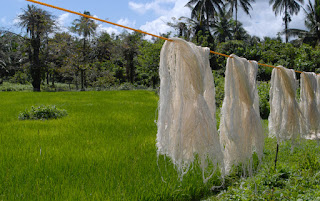Introduction
Waste is not only an environmental problem but also and economic loss. Because of the long degradation process, products have been accumulated forming a huge amount of waste. Designers have researched in transforming these leftover resources in the mass production industry to new materials. "Forest Wool" and "Piñatex" are two great examples.
"Forest Wool"
The world’s primary ingredient of timber is pine trees. "Every year 600 million pine trees are cut down in the EU only. But there is more to the tree than just wood: pine needles account for 20 to 30 percent of its mass. " (Orjola, 2016) Designer Tamara Orjola researched the value of pine needles, which is the leftover material in the industry, and transformed it to an innovative and sustainable material.
"By crushing, soaking, steaming, binding and pressing the needles, Orjola extracts the pine needles' fibre and transforms it into textiles, composites, and paper. The process also allows essential oils and dye to be extracted and used." (Tucker, 2016) Orjola has made a pair of minimal benches and oval carpet from this material and exhibited them in dutch design week.
Because mass production is unwilling to adopt less sufficient source, valuable material and technique have been forgotten. Orjola's project is aim to bring that back.
"Piñatex"
Pineapple leaves have been regarded as an agricultural-by product and are often burned or left or rot. "An estimated 40,000 tons of this pineapple waste is generated globally each year" (Tucker, 2016) Piñatexis a unique natural and sustainably made from pineapple leaf. This animal-friendly material could be used as an alternative to leather.
" The fibres are extracted from the leaves during a process called decortication, which is done at the plantation by the farming community. Furthermore, the by-product of decortication is bio-mass, which can be further converted into organic fertilizer or bio-gas." "Both the extraction of the fibers and the consequent bio-mass will bring added revenue stream to the farming communities." (Anam, 2016) The fibres have then been through an industrial process with local factories to become a nonwoven textile.
"The fabric is strong, versatile, breathable, soft, light, flexible, and can be easily printed on, stitched and cut." (Anam, 2016) It can be used for making clothes, shoes, bags or furniture.
 |
| Local Factories in the Philippines separate strains and felt them together into a non-woven fabric |
Commonalities
These two projects are both extremely environmentally friendly. They focus on the leftover material which has usually been ignored, and turned these waste into new materials for production. In terms of techniques, they both transform the original material by extracting fibre from them. By doing this, the waste transformed to a completely different and biodegradable material.
Wider Implications of Nature Fibre
"There has been an increasing interest in biodegradable renew- able composites reinforced with plant fibers."(Faruk et al., 2012) These materials have been sufficient due to intensively researched developed and frequently applied new compositions and process. While environmental awareness and the demand for sustainable technology is rapidly increasing. "The use of natural fibers instead of traditional reinforcement materials, such as glass fibers, carbon, and talc, provides several advantages, including low density, low cost, good specific mechanical properties, reduced tool wear and biodegradability. " (Ayrilmis, Ashori and Heon, 2016) Furthermore, the ingredient is profoundly avaliable make it a good area to research in. Plant fiber has been used to produce packaging, furniture, clothes, etc. I believe as the environmental awareness increasing and technology developing, nature fibre will be developed into a greater variety of products and commonly used by people.
Reference
Anam, A. (2016). Introducing Piñatex™ - ananas anam. [online] Available at: http://www.ananas-anam.com/pinatex/ [Accessed 21 Dec. 2016].
Ayrilmis, N., Ashori, A. and Heon, J. (2016). Properties and Utilization of Plant Fibers and Nanocellulose for Thermoplastic Composites. In: P. Visakh and S. Lüftl, ed., Polyethylene-Based Biocomposites and Bionanocomposites, 1st ed. Scrivener Publishing LLC, p.406.
Faruk, O., Bledzki, A., Fink, H. and Sain, M. (2012). Biocomposites reinforced with natural fibers: 2000–2010. Progress in Polymer Science, 37(11), pp.1552-1596.
Orjola, T. (2016). Forest wool. [online] Tamaraorjola.com. Available at: http://www.tamaraorjola.com [Accessed 21 Dec. 2016].
Tucker, E. (2016). Leather alternative Piñatex is made from pineapple leaves. [online] Dezeen. Available at: https://www.dezeen.com/2016/06/09/pinatex-ananas-anam-vegan-leather-alternative-ethical-recycled-pineapple-leaves-sustainable-materials-design-camper/ [Accessed 21 Dec. 2016].
Tucker, E. (2016). Tamara Orjola makes furniture and textiles using pine needles. [online] Dezeen. Available at: https://www.dezeen.com/2016/11/07/tamara-orjola-forest-wool-pine-needle-furniture-textiles-sustainable-dutch-design-week-2016/ [Accessed 21 Dec. 2016].





No comments:
Post a Comment